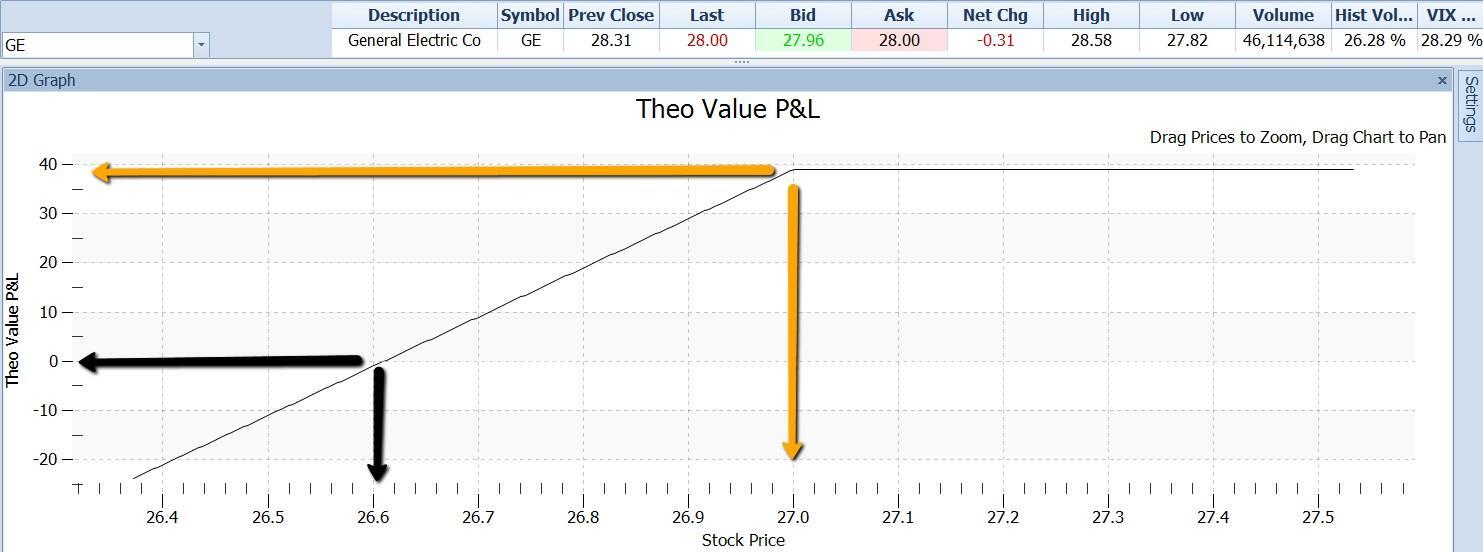When trading options, we have quite a few moving parts to juggle. Fortunately, technology now gives us tools that make this much easier.
One of those tools is the option payoff graph, also called the risk graph. We’ll take a look at this tool today.
We have been using the stock of General Electric for our examples recently, so let’s continue with that. Here’s how GE’s chart looked on January 27, 2016:
Let’s say we were neutral-to-bullish on GE and expected it to hold or go higher from here in the next few weeks. We might consider the trade that I described last week, which was to sell (short) put options for the February 19, 2016 expiration at the $27 strike price. These could be sold for $.39 per share, or $39.00 per 100-share option contract.
To view the profit and loss possibilities of an option position, there is a standard format for portraying them graphically. The option payoff graph for this short put trade looks like this:
The gray line on this graph relates the stock price at the option expiration date to the amount of profit or loss that the option position would make with the stock at that price. The system “knows” that we would receive $39 when we sold the puts to enter the position.
These graphs take a little getting used to for those of us accustomed to using stock price charts. Note these points about the payoff graph:
-
The price of the stock runs left to right (on the X or horizontal axis), not up and down on the Y or vertical axis, as price charts do.
-
The vertical axis is profit or loss on the position at the indicated stock price.
-
Not shown but, built into the graph is the amount of money paid out or taken in to open the position. In our example, we sold puts for $39.00 for the contract.
-
No time or movement is shown on the graph. The gray line is drawn as of a specific instant in time – the moment of option expiration, 23 days in the future. It shows what the amount of profit or loss would be if the stock were to be at the indicated price at that time.
In this case, the gray line slopes upward from left to right and then levels out at a profit of $39.00. This indicates that the maximum profit on the trade is $39.00 and that this would be the result if the stock were to be at any price at or above $27.00 at expiration. The gold arrows point to the amount of profit ($39.00) and to the corresponding stock price ($27.00).
This makes sense when we remember that the puts will be worthless when they expire unless the stock is below their strike price of $27.00. If they are worthless then we will not have to pay anything to buy them back and terminate the trade, and we will keep the $39.00 we received for them. This will be our profit.
The black arrows point to the zero point on the P/L axis and to the corresponding stock price of $26.61. This indicates that if at expiration the stock is at $26.61, our trade will break even. In that case the puts would be worth $.39 per share. They convey the right to their holders to force us to buy the stock and pay $27.00 (their strike price), which would certainly happen. Since $27.00 would be $.39 higher that the stock value at that point, we would have a loss at that time of $.39 per share. This would exactly absorb our original credit of $.39 per share, for no net gain or loss.
At stock prices between $26.61 and $27.00 our position shows positive values for profit of more than zero and less than the maximum profit of $39.00.
And at stock prices below the $26.61 break-even price the position would show a loss.
There is quite a bit more that the option payoff graph can tell us. Next time we’ll continue with that.
This content is intended to provide educational information only. This information should not be construed as individual or customized legal, tax, financial or investment services. As each individual's situation is unique, a qualified professional should be consulted before making legal, tax, financial and investment decisions. The educational information provided in this article does not comprise any course or a part of any course that may be used as an educational credit for any certification purpose and will not prepare any User to be accredited for any licenses in any industry and will not prepare any User to get a job. Reproduced by permission from OTAcademy.com click here for Terms of Use: https://www.otacademy.com/about/terms
Editors’ Picks

EUR/USD flat lines near 1.1750 ahead of ECB policy decision
EUR/USD remains flat after two down days, trading around 1.1750 in the European session on Thursday. Traders move to the sidelines and refrain from placing any fresh directional bets on the pair ahead of the ECB policy announcements and the US CPI inflation data.

GBP/USD stays defensive below 1.3400, awaits BoE and US CPI
GBP/USD oscillates in a narrow band below 1.3400 in European trading on Thursday. The pair trades with caution as markets eagerly await the BoE policy verdict and US consumer inflation data for fresh directional impetus.

Gold awaits weekly trading range breakout ahead of US CPI report
Gold struggles to capitalize on the previous day's move higher back closer to the $4,350 level and trades with a mild negative bias during the Asian session on Thursday. The downtick could be attributed to some profit-taking amid a US Dollar uptick, though it is likely to remain cushioned on the back of a supportive fundamental backdrop.

BoE set to resume easing cycle, trimming interest rate to 3.75%
The Bank of England will announce its last monetary policy decision of 2025 on Thursday at 12:00 GMT. The market prices a 25-basis-point rate cut, which would leave the BoE’s Bank Rate at 3.75%.

US CPI data expected to show inflation rose slightly to 3.1%, cooling Fed rate cut bets for January
The US Bureau of Labor Statistics will publish the all-important Consumer Price Index (CPI) data for November on Thursday at 13:30 GMT. The CPI inflation in the US is expected to rise at an annual rate of 3.1% in November
RECOMMENDED LESSONS
Making money in forex is easy if you know how the bankers trade!
I’m often mystified in my educational forex articles why so many traders struggle to make consistent money out of forex trading. The answer has more to do with what they don’t know than what they do know. After working in investment banks for 20 years many of which were as a Chief trader its second knowledge how to extract cash out of the market.
5 Forex News Events You Need To Know
In the fast moving world of currency markets where huge moves can seemingly come from nowhere, it is extremely important for new traders to learn about the various economic indicators and forex news events and releases that shape the markets. Indeed, quickly getting a handle on which data to look out for, what it means, and how to trade it can see new traders quickly become far more profitable and sets up the road to long term success.
Top 10 Chart Patterns Every Trader Should Know
Chart patterns are one of the most effective trading tools for a trader. They are pure price-action, and form on the basis of underlying buying and selling pressure. Chart patterns have a proven track-record, and traders use them to identify continuation or reversal signals, to open positions and identify price targets.
7 Ways to Avoid Forex Scams
The forex industry is recently seeing more and more scams. Here are 7 ways to avoid losing your money in such scams: Forex scams are becoming frequent. Michael Greenberg reports on luxurious expenses, including a submarine bought from the money taken from forex traders. Here’s another report of a forex fraud. So, how can we avoid falling in such forex scams?
What Are the 10 Fatal Mistakes Traders Make
Trading is exciting. Trading is hard. Trading is extremely hard. Some say that it takes more than 10,000 hours to master. Others believe that trading is the way to quick riches. They might be both wrong. What is important to know that no matter how experienced you are, mistakes will be part of the trading process.
The challenge: Timing the market and trader psychology
Successful trading often comes down to timing – entering and exiting trades at the right moments. Yet timing the market is notoriously difficult, largely because human psychology can derail even the best plans. Two powerful emotions in particular – fear and greed – tend to drive trading decisions off course.


